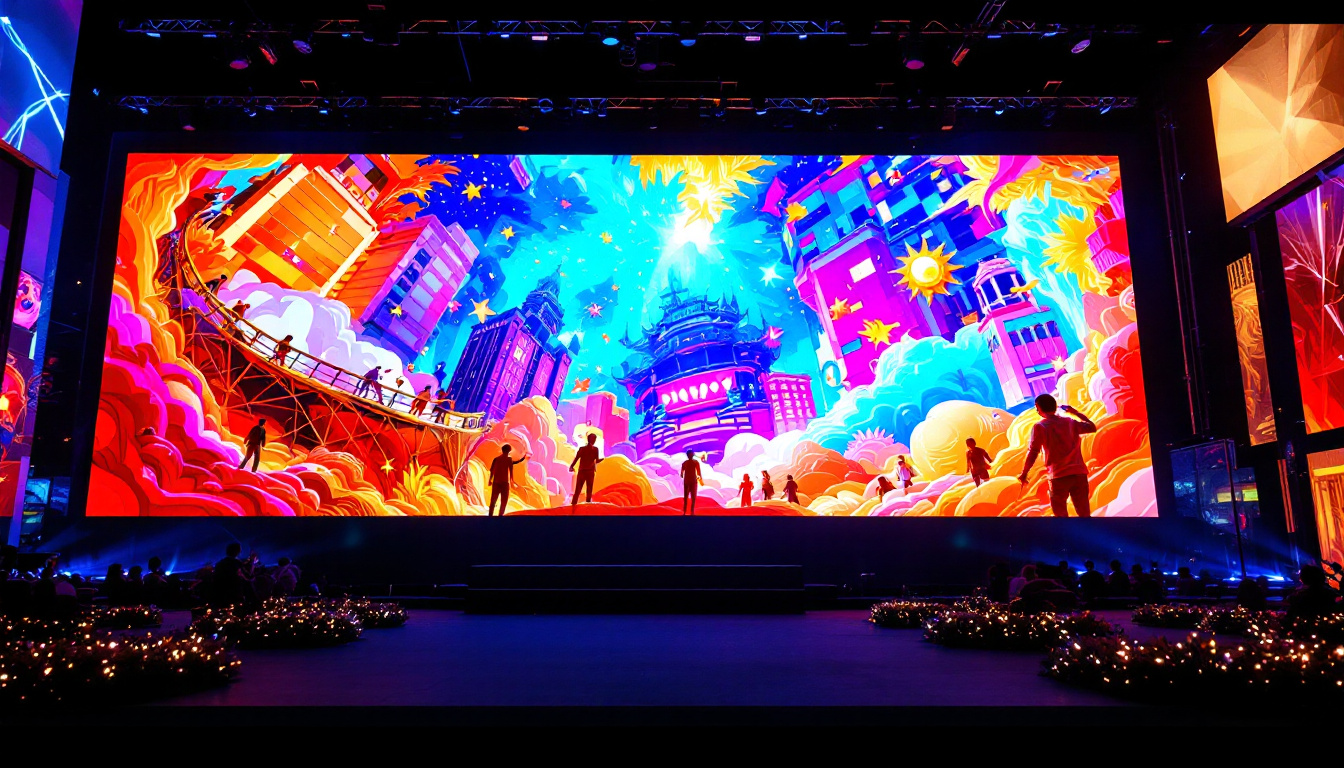In the realm of modern technology, displays play a crucial role in how we interact with devices. Among the various types of displays, LCD (Liquid Crystal Display) and LED (Light Emitting Diode) technologies are among the most prevalent. Understanding the differences, advantages, and applications of these technologies can help consumers make informed choices. This article delves into the intricacies of LCD displays and explains how LED technology enhances them.
Understanding LCD Technology
LCD technology has revolutionized the way images are displayed on screens. By utilizing liquid crystals, these displays can manipulate light to create images. The fundamental principle behind LCDs is their ability to control the passage of light through liquid crystals, which are sandwiched between two layers of glass or plastic.
How LCDs Work
At the core of an LCD is a backlight that provides illumination. The liquid crystals themselves do not emit light; instead, they modulate the light from the backlight. When an electric current is applied, the orientation of the liquid crystals changes, allowing varying amounts of light to pass through. This process enables the display to create images by blocking or allowing light to reach the viewer’s eyes.
Typically, LCDs use a combination of red, green, and blue (RGB) filters to produce a full spectrum of colors. By adjusting the intensity of each color, LCDs can create vibrant images that are sharp and clear. However, traditional LCDs have limitations in terms of color accuracy and contrast, which brings us to the role of LED technology. Recent advancements have led to the development of LED-backlit LCDs, which enhance brightness and improve color reproduction by using LEDs as the light source instead of traditional fluorescent tubes. This innovation not only results in better energy efficiency but also allows for thinner display designs, making them more versatile for various applications.
Types of LCD Displays
There are several types of LCD displays, each with its unique characteristics. The most common types include:
- Twisted Nematic (TN): Known for fast response times, TN panels are often used in gaming monitors. However, they have limited viewing angles and color reproduction.
- In-Plane Switching (IPS): IPS panels offer better color accuracy and wider viewing angles, making them ideal for graphic design and professional use.
- Vertical Alignment (VA): VA panels provide excellent contrast ratios and are suitable for watching movies and playing games in dark environments.
Each type has its advantages and disadvantages, making them suitable for different applications. Understanding these differences is essential for selecting the right display for specific needs. Additionally, the rise of high-definition and ultra-high-definition (4K) resolutions has pushed manufacturers to innovate further, leading to the emergence of advanced technologies such as Quantum Dot and Mini-LED displays. These technologies aim to enhance color accuracy and brightness, offering users an even more immersive viewing experience. As the demand for high-quality displays continues to grow, the evolution of LCD technology remains a pivotal aspect of the visual media landscape.
The Role of LED in LCD Technology
While LCD technology was groundbreaking, the introduction of LED backlighting has significantly enhanced the performance of LCD displays. LED backlighting provides several advantages over traditional fluorescent backlighting, which was commonly used in earlier LCDs.
Benefits of LED Backlighting
LED backlighting offers numerous benefits that improve the overall quality of LCD displays:
- Improved Brightness: LED backlights can produce higher brightness levels compared to traditional fluorescent lights, resulting in clearer images even in well-lit environments.
- Better Contrast: With the ability to dim or turn off individual LEDs, LED backlighting enhances contrast ratios, allowing for deeper blacks and more vibrant colors.
- Energy Efficiency: LED technology is more energy-efficient, consuming less power than traditional backlighting methods, which is beneficial for both consumers and the environment.
These advantages have made LED-backlit LCDs the preferred choice for many consumers, leading to their widespread adoption in televisions, computer monitors, and mobile devices. Furthermore, the longevity of LED lights contributes to the overall lifespan of the display, reducing the frequency of replacements and maintenance. This durability not only offers cost savings over time but also minimizes electronic waste, aligning with global sustainability efforts.
Different LED Backlighting Techniques
There are primarily two types of LED backlighting techniques used in LCD displays: edge-lit and full-array.
- Edge-Lit LED: In this configuration, LEDs are positioned along the edges of the screen. Light is then distributed across the display using a light guide panel. This method allows for thinner displays but may result in uneven brightness in certain areas.
- Full-Array LED: Full-array backlighting involves placing LEDs directly behind the entire screen. This configuration allows for local dimming, improving contrast and overall image quality. However, full-array displays tend to be thicker and more expensive.
Choosing between these techniques depends on the desired balance between image quality, form factor, and cost. Additionally, advancements in technology have led to hybrid solutions that combine the benefits of both methods, providing consumers with options that cater to varying preferences and budgets. As manufacturers continue to innovate, we may see even more sophisticated backlighting techniques that enhance the viewing experience further, making displays not only brighter and more vibrant but also more adaptable to different viewing conditions.
Applications of LCD and LED Displays
The versatility of LCD and LED displays has led to their adoption in a wide range of applications. From consumer electronics to industrial uses, these displays have become integral to modern life.
Consumer Electronics
LCD and LED displays are ubiquitous in consumer electronics, including televisions, smartphones, tablets, and laptops. The high resolution and vibrant colors offered by these displays enhance the viewing experience for entertainment, gaming, and productivity.
Television manufacturers have embraced LED-backlit LCD technology to produce stunning visuals, with many models now supporting 4K and 8K resolutions. In smartphones and tablets, the combination of LCD and LED technology ensures that users enjoy bright, colorful images, whether browsing the web or watching videos. Furthermore, advancements in OLED (Organic Light Emitting Diode) technology, a subset of LED, have introduced deeper blacks and improved contrast ratios, making displays even more appealing for high-definition content consumption.
Industrial and Commercial Use
Beyond consumer electronics, LCD and LED displays find applications in various industrial and commercial settings. Digital signage, for instance, utilizes large LCD panels to convey information in retail environments, transportation hubs, and public spaces. The ability to display dynamic content makes these displays an effective marketing tool. Retailers can easily update promotions and advertisements in real-time, capturing the attention of potential customers and enhancing their shopping experience.
In industrial settings, LCDs are commonly used in control panels and monitoring systems. Their clarity and reliability are essential for operators who need to make quick decisions based on real-time data. Additionally, many manufacturing facilities utilize LED displays for process monitoring, providing critical information such as production rates and equipment status. This not only aids in operational efficiency but also enhances safety by ensuring that workers are informed about potential hazards in their environment. The increasing integration of smart technology with these displays further allows for remote monitoring and control, making them a cornerstone of modern industrial automation.
Future Trends in Display Technology
The display technology landscape is continually evolving, with advancements aimed at improving performance, energy efficiency, and user experience. Several trends are shaping the future of LCD and LED displays.
OLED Technology
One of the most significant developments is the rise of OLED (Organic Light Emitting Diode) technology. Unlike LCDs, OLED displays do not require a backlight, as each pixel emits its light. This results in deeper blacks, wider viewing angles, and improved color accuracy. As OLED technology becomes more affordable, it is expected to challenge traditional LCDs in high-end applications. Furthermore, the flexibility of OLED panels allows for innovative designs, such as curved and foldable screens, which can enhance the aesthetic appeal of devices while providing a more immersive viewing experience.
MicroLED Displays
Another emerging technology is MicroLED, which combines the benefits of both LCD and OLED. MicroLED displays consist of tiny, self-emitting LEDs that can create images with incredible brightness and color accuracy. This technology promises to deliver the best of both worlds, with high contrast ratios and energy efficiency. Additionally, MicroLED panels are highly scalable, meaning they can be configured into various sizes and shapes, making them suitable for everything from small wearables to large-scale digital signage. This adaptability opens up new possibilities for creative applications in both commercial and residential settings.
As these technologies mature, they may redefine the standards for display quality and performance, offering consumers even more choices in the future. Moreover, the integration of artificial intelligence with display technologies is also on the horizon. AI algorithms can optimize image processing, enhance color reproduction, and even adjust display settings based on ambient light conditions, further elevating the user experience. With these advancements, the future of display technology promises not only improved visual fidelity but also smarter, more responsive devices that cater to individual preferences and environments.
Conclusion
LCD and LED displays have transformed the way images are presented across various devices. With their unique characteristics and advantages, they cater to a wide range of applications, from everyday consumer electronics to specialized industrial uses. As technology continues to advance, the future of displays looks promising, with innovations like OLED and MicroLED on the horizon.
Understanding these technologies not only helps consumers make informed decisions but also highlights the remarkable progress that has been made in display technology. Whether for work, entertainment, or communication, the impact of LCD and LED displays is undeniable, shaping the way we experience visual content in our daily lives.
Discover Cutting-Edge LED Display Solutions
As you consider the advancements and future of display technologies, why not experience the pinnacle of LED innovation with LumenMatrix? Our extensive range of LED display modules, from Indoor and Outdoor LED Walls to Custom and All-in-One LED Displays, is designed to captivate and engage. Whether for advertising, live events, or unique installations, LumenMatrix is committed to enhancing your brand’s visibility and creating immersive visual experiences. Check out LumenMatrix LED Display Solutions today and see how we can transform your visual communication.































